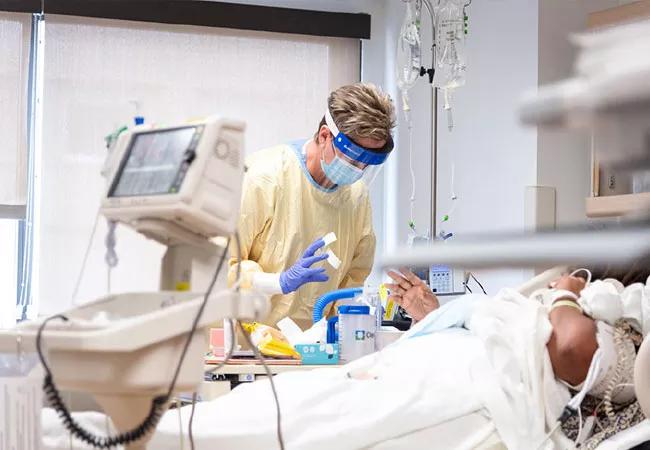Findings from a 24/7 central monitoring unit yield insights for care outside pandemic epicenters

Blood levels of C-reactive protein (CRP) and lactic dehydrogenase (LDH) at the time of non-ICU admission for COVID-19 predict likelihood of adverse outcomes, including development of more serious illness, increased oxygen requirements or ICU transfer. So finds the first detailed characterization of clinical course among COVID-19 patients admitted to a non-ICU setting outside a COVID-19 epicenter, using a remote central monitoring unit (CMU).
Advertisement
Cleveland Clinic is a non-profit academic medical center. Advertising on our site helps support our mission. We do not endorse non-Cleveland Clinic products or services. Policy
The study was recently published online in the Journal of Hospital Medicine.
“CRP and LDH blood levels can help stratify risk and prioritize resource allocation for non-ICU patients with COVID-19,” says the study’s lead author, Daniel Cantillon, MD, Medical Director of the Cleveland Clinic CMU.
“One aim of this investigation was to identify low-risk patients who may not require continuous monitoring,” he adds. “We found that COVID-19 patients without a prior history of cardiac disease and those with a negative troponin test are at low risk for cardiac arrhythmias and can potentially forgo cardiac monitoring. This represents an opportunity to conserve resources, including personal protective equipment, and reduce caregiver exposure to the virus.”
COVID-19 outcomes data have been collected predominantly from critically ill patients in hospitals operating at surge-level capacity. But most hospitals caring for COVID-19 patients in the U.S. and worldwide do not fit that description. They must also continue to care for non-COVID-19 patients and allocate resources so that all patients are cared for optimally.
Cleveland Clinic has been a nonepicenter healthcare system during the COVID-19 pandemic. For the past few years, it has used off-site 24/7 central monitoring for non-ICU hospitalized patients, providing standardized monitoring of cardiac telemetry and pulse oximetry. (For more on Cleveland Clinic’s CMU, see this previous Consult QD post.)
“The CMU allows us to quickly detect a potentially dangerous change in a patient’s condition and inform the nursing staff so they can promptly escalate care as needed,” says Dr. Cantillon. “When the pandemic hit, we realized we could use the CMU infrastructure not only to optimize care for patients with COVID-19 but to learn more about the behavior of this virus.”
Advertisement
The study analyzed non-ICU patients hospitalized at Cleveland Clinic for COVID-19 who were monitored via the CMU and discharged between March 13 and May 1, 2020. There were 350 such patients (mean age, 64 ± 16 years; 55% male) during this period. Average length of stay was 6.1 ± 5.9 days.
Adverse events. The primary outcome — combined incidence of death, ICU transfer or increased oxygen requirement — occurred in 62 patients (18%). Overall, 49 patients (14%) required escalation to high-flow nasal cannula, noninvasive ventilation or mechanical ventilation, and 48 (14%) required ICU transfer. Clinical decompensation was found to be driven largely by respiratory complications. There were 22 deaths (6%), about half the rate reported in COVID-19 epicenter regions.
In multivariable analysis, adverse events were independently associated with the following test results:
Arrhythmias. Telemetry was used for 79% of patients, with arrhythmias occurring in 14%. Of these, 90% had abnormal troponin levels or known cardiovascular disease. Ventricular tachycardia occurred in 5%; all cases were unsustained and not associated with hydroxychloroquine or azithromycin therapy.
According to Dr. Cantillon, primary lessons learned from the study include the following:
Advertisement
As a result of this first study to report that LDH and CRP are independent predictors of COVID-19 severity, Dr. Cantillon recommends, at a minimum, conducting an ECG and obtaining troponin, CRP and LDH levels for all patients admitted with COVID-19 to help anticipate disease course and guide care. He notes that such information is especially important as hospital services not related to COVID-19 return to prepandemic levels.
“These biomarkers help us prioritize patients for respiratory support and continuous cardiac monitoring, as such services may be limited and involve more caregiver exposure and use of personal protective equipment,” adds study co-author Oussama Wazni, MD, Section Head of Electrophysiology at Cleveland Clinic. “They also can provide trigger points for escalating therapy for COVID-19.”
Advertisement
Advertisement

Patients report improved sense of smell and taste

Clinicians who are accustomed to uncertainty can do well by patients

Unique skin changes can occur after infection or vaccine

Cleveland Clinic analysis suggests that obtaining care for the virus might reveal a previously undiagnosed condition

As the pandemic evolves, rheumatologists must continue to be mindful of most vulnerable patients

Early results suggest positive outcomes from COVID-19 PrEP treatment

Could the virus have caused the condition or triggered previously undiagnosed disease?

Five categories of cutaneous abnormalities are associated with COVID-19